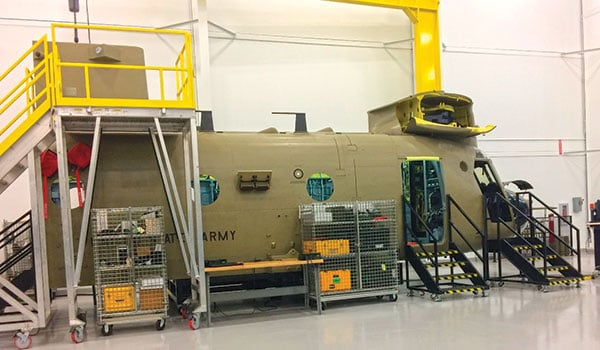
128th Aviation Brigade / By SSG Jerome Penwright, Jr.: Avionics is the amalgamation of two words, aviation and electronics. It is a general term for all electrical equipment used in Army aircraft.

C/1-210th Avn. Regt. Chinook Avionics Trainer (CAT) with Instructor Operating Station, far right, at Joint Base Langley-Eustis, VA./ 128th AVN BDE PHOTO BY SSG JEROME PENWRIGHT
The Military Occupational Specialty 15N Avionics Repairer performs maintenance on tactical components the pilot directly uses, such as navigation, radio communication, survivability and flight control equipment. In addition, avionics repairers maintain other electronic systems not directly used by the pilot that control and monitor system performance for both the UH-60 Blackhawk and the CH-47 Chinook helicopters. Soldiers receive flight line safety training, learn how to research specific interactive electronic aircraft technical manuals (IETM), basic electronics, wire maintenance, and troubleshooting. They learn multiple aircraft systems and how to identify specific system faults, referencing wiring schematics, performing diagnostic checks and inspections with test equipment and special tools, and how to replace components or line replaceable units (LRUs). In this article I am going to focus on the latest CH-47F training device used in training 15N Soldiers at the 128th Aviation Brigade.
Chinook Avionics Trainer
Maintaining avionics and communication systems for the CH-47F Chinook aircraft is critical to support the availability rates needed for today’s operational tempo. To do this, the civilian and military instructors with Company C, 1st Battalion, 210th Aviation Regiment at Joint Base Langley-Eustis, Virginia are tasked with producing over 3,500 U.S. Army and international avionics maintainers per year. To do this they use one of the most technologically advanced trainers in the world, the Chinook Avionics Trainer or CAT.
The CAT is comprised of several components beginning with the Instructor Operator Station (IOS). This component enables the instructor to accomplish training objectives by monitoring and storing student progress which allows the instructor to choose the environmental setting, enter an avionics fault, and alter conditions in the Student Station while monitoring the student’s steps in the fault isolation/troubleshooting process. A Computer Control Cabinet Assembly holds all the “brains’ of the device, and a Student Station is where the student interfaces with the training device through switchology and control inputs. An ethernet system linked to a host computer provides intercommunication between the trainer components.
The CAT assists in the development of maintenance and troubleshooting skills for CH-47F avionics mechanics. Its functional systems provide practical training for maintenance procedures and operations. It is the primary training device used to increase CH-47F avionics soldiers’ knowledge and skills by providing familiarization of specific avionic systems through a list of individual critical tasks such as locating aircraft components, inspections, and using proper maintenance procedures and test, measurement, and diagnostic equipment (TMDE). The CAT also assists the instructor to demonstrate how to remove, install, replace or adjust any component within a specific system while following step-by-step procedures outlined by the technical manual. On the CAT the student learns to perform proper maintenance operation checks (MOC) which are vital to troubleshooting faulty components or systems. This allows the maintainer to verify the fault, follow the proper fault isolation procedure (FIP) associated with the failing component in a system, and repair or replace the component.
The brigade has four CAT trainers on hand, with one receiving upgrades through the Aircraft Product Improvement Program One (PIP1) system upgrade by the simulator’s manufacturer. This upgrade will include the addition of the ARC-231 SATCOM Communication System to the avionics suite. Future upgrades will enable the trainer to maintain compatibility with the actual CH-47 aircraft, implement functional upgrades, such as allowing the simulators to network together enabling students to complete enhanced maintenance scenarios. A Simulated Aircraft Control Tower or (SACT) station is included in the upgrade that will allow soldiers to learn proper radio procedures as they test radio communications.
Properly functioning upgraded avionics are critical to the mission of Army aviation and to the safety of the aircrews and Soldiers who fly in them. C/1-210th Avn. is committed to keeping pace with changes in technology and upgrades to our CATs that will provide maintainers the most effective training. The Chinook Avionics Trainer is a valuable asset for providing support to training which leads to results in combat.
SSG Jerome Penwright, Jr. is a 15N writer/instructor with Co. A, 1st Bn., 210th Avn. Regt., 128th Avn. Bde. at Joint Base Langley-Eustis, VA.







